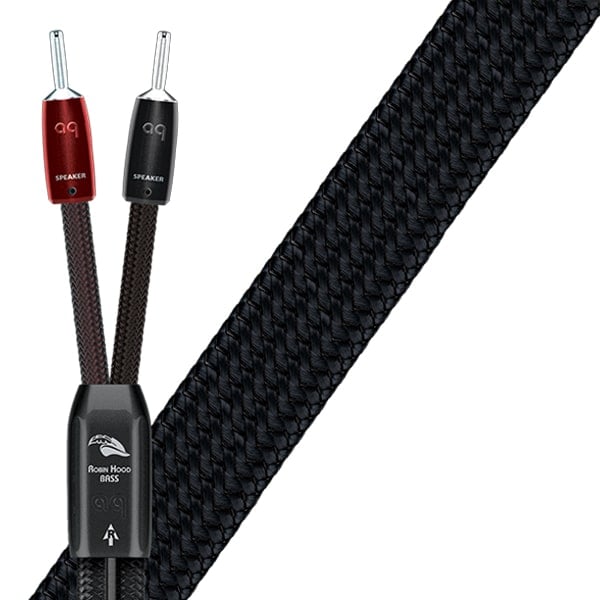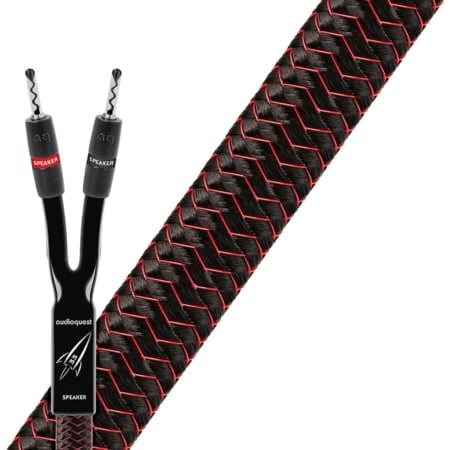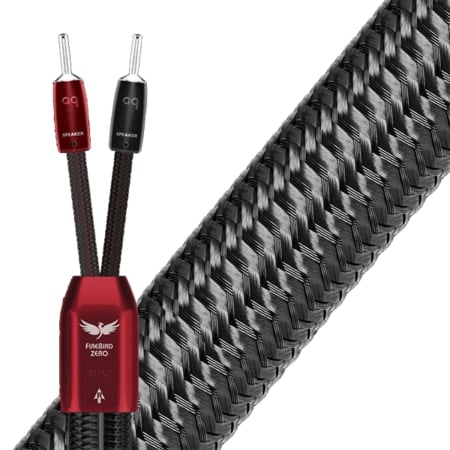Description
AudioQuest Robin Hood BASS speaker cable
Robin Hood BASS with RF/ND-Tech is an ideal cable for the bass and midrange inputs of either a Bi-Wireable or Tri-Wireable loudspeaker when used in combination with Robin Hood ZERO or Robin Hood SILVER Full-Range cables.
RF/ND-Tech (patented radio-frequency ground-noise dissipation)
Though a cable’s ground leads are integral to a component’s signal transmission, they also act as an antenna, making them subject to induced radio-frequency (RF) noise. RF noise is a parasitic signal that is typically coupled directly into a system’s most sensitive audio/video circuits. AudioQuest’s RF-on-ground noise-dissipation (RF/ND-Tech) greatly reduces distortion and signal masking, yielding unprecedented levels of noise dissipation across the widest bandwidth of radio frequencies possible. The unique circuit topology uses a common-mode phase-cancelling array, providing linear noise dissipation across the entire length of the cable.
Solid perfect-surface copper+ (PSC+) conductors
Solid conductors prevent strand interaction, a major source of dynamic distortion. Extreme-purity PSC+ solid copper minimizes distortion caused by grain boundaries, and, when direction-controlled for surface asymmetry, facilitates crucial radio-frequency noise dissipation.
ZERO-Tech for uncompressed current transfer and linear noise dissipation
The only complete way to eliminate characteristic-impedance mismatches between a cable and the attached source and load is for the cable not to have any fixed characteristic-impedance value. ZERO-Tech accomplishes this by eliminating interaction between the insulation (dielectric) and the cable’s conductors—enabling uncompressed current transfer. All-important transient current is unrestricted, and RF noise dissipation is linearized (consistent octave to octave).
72v dielectric-bias system (DBS)
Insulation is also a dielectric that can act like a shunt filter. Biasing minimizes dielectric noise and linearizes the filter, significantly improving wide-bandwidth dissipation of induced RF noise.
Directional conductors
All drawn metal strands or conductors have a non-symmetrical grain structure, resulting in directional conductors. AudioQuest controls the resulting RF impedance variation so that noise is drained away from where it will cause distortion. Arrows are marked on the connectors to ensure superior sound quality and optimal noise dissipation.
Carbon-based linearized noise-dissipation system (NDS)
Today’s environment is saturated with radio-frequency noise from sources such as satellites, cellular towers, and Bluetooth. AQ’s comprehensive linearized noise-dissipation system combines multiple shields and a carbon-based linearized resistive network to turn most of this noise into heat. The system is equally effective across a wide bandwidth, rather than only at selected frequencies. The remaining bad energy is drained away from sensitive amplifier circuits via directionally controlled signal and shield conductors.
Robin Hood Bi-Wiring
When possible, running separate cables to the treble and bass “halves” of a speaker significantly reduces distortion. Bi-Wiring keeps the large magnetic fields associated with bass energy out of the treble cable, allowing the delicate upper frequencies to travel a less magnetically disturbed path. AudioQuest’s RF/ND-Tech attracts RF energy away from the amplifier’s output, making Bi-Wiring even more effective.
Caution: Do not Bi-Wire with two ZERO cables. Use a ZERO plus a BASS cable instead. A Bi-Wire COMBO with BASS and ZERO cables joined together at the amplifier is usually most convenient.
Folk Hero cold-welded terminations
Folk Hero cables are cold-welded to AudioQuest’s extremely pure Red Copper Spades or Bananas. The bare copper is submerged in a vat of pure silver to ensure a high-quality connection. AudioQuest speaker breakouts and plug casings are not metal to avoid inducing RF noise into the conductors.
KEY FEATURES:
• RF/ND-Tech for unprecedented noise dissipation and reduced distortion
• Solid perfect-surface copper+ (PSC+) for superior clarity and reduced grain-boundary distortion
• ZERO-Tech for uncompressed current transfer and optimal transient response









